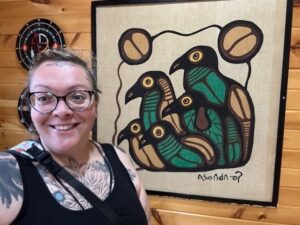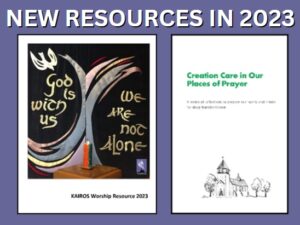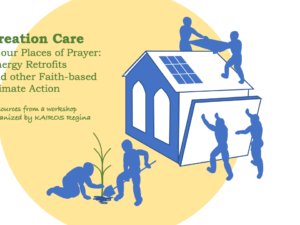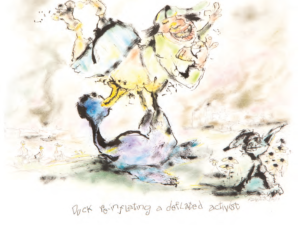The World is About to Turn: Sermon on Luke 1: 46-55 by Jennifer Henry

“My heart shall sing of the day you bring. Let the fires of your justice burn. Wipe away all tears, for the dawn draws near, and the world is about to turn.”
–Canticle of the Turning, Rory Cooney
On June 2, 2015 the Truth and Reconciliation Commission released its summary report and 94 calls to action. Inspired by Métis Activist Chelsea Vowel’s challenge to read the report, young Indigenous activists organized on Twitter to create a series of YouTube videos of themselves reading the 388 pages out loud under the hashtag #ReadtheTRCReport. Their determination came from a complete unwillingness to have this report shelved like the 1996 Report of the Royal Commission on Aboriginal Peoples, and so many others before it. Could the country be about to turn?
On July 5 people took to the streets in Toronto under the banner Jobs, Justice, Climate, a living embodiment of a statement later released as the LEAP Manifesto. The organizers worked very hard to show no divisions between jobs and the environment, or between global ecological justice and local challenges of racism and poverty. Faith leaders stood beside union leaders beside environmentalists and anti-racism activists, and perhaps most important of all, Indigenous peoples voices and experiences were given priority of place. On November 29 an estimated 785,000 people participated in 2,300 events in 175 countries. The focus was on the possible, a world powered by 100 per cent clean energy by mid century. Could the world be about to turn?
On September 2 the picture of 3-year old Aylan Kurdi lying dead on a Turkish beach went across the globe. Instead of another apathetic response, a reaction out of peoples’ desensitization to tragedy and horror, a country, a world, woke up. Rallies under the banner #refugeeswelcome sprung up in communities across Canada, and people from every walk of life began to ask: how might we sponsor a refugee family? My own church community which has sponsored over 100 refugees since 1991 was inundated with inquiries from people wishing to open their doors, their lives. Canadians, who had tolerated the introduction of regressive refugee policies over the last years, made generous welcome an election issue. Could the country be about to turn?
And on November 4, a new cabinet was sworn in. Much has been made of its gender parity. But just as critical were some changes in the ceremony itself, changes that very well may extend through other cabinets, other governments. The ceremony began by recognizing the traditional territory of the Algonquin peoples. Mirroring the Heart Garden ceremonies that closed the Truth and Reconciliation Commission, the proceedings included First Nations, Inuit and Métis children, recognizing the three Aboriginal groups named in our Constitution. The First Nation’s drummer was Theland Kicknosoway, a 13-year old young man, steeped in his culture and tradition and to our honour at KAIROS, a Blanket Exercise facilitator with his Mom Elaine. A few days later the Government of Canada announced it would implement the UN Declaration on the Rights of Indigenous Peoples. Could the country be about to turn?
The great turning text of the Christian faith is the Magnificat (Luke 1:46-55). It is a text we often claim as KAIROS. As an ecumenical movement, its words both inspire and challenge us to seek what seems impossible. The words, likely an ancient anthem, were interpreted by Rory Cooney in the contemporary language of a hymn entitled Canticle of the Turning. This is its chorus: “My heart shall sing of the day you bring. Let the fires of your justice burn. Wipe away all tears, for the dawn draws near, and the world is about to turn.”
In Cooney’s interpretation, and in the traditional words, it is clear that Mary’s anthem is a bold song of liberation, not easily spiritualized or softened. It always strikes me that those who would portray Mary in a diminutive manner have not fully absorbed Luke 1: 46-55. Yes, there is a humbleness, even meekness or lowliness, but this can be understood as more of a description of her social status rather than her personal qualities. Out of her marginalized placement, the Mary of Luke’s gospel sings of her deep confidence in the transforming power of God to turn the world upside down—the power of God to bring justice to all poor and oppressed. Her voice, as essentially the first disciple, is even stronger when contrast in the text to the male priest, Zechariah who ends up silenced. He can no longer speak while she proclaims God’s promise, a set of Jubilee reversals still so unsettling for ruling powers that at least three times in this last century governments or militaries have banned the public reading or singing of this gospel truth.[i]
It’s a woman’s song, first originating in the scriptures in the voice of Hannah in Samuel 1. Neither woman’s voice is glib nor a product of naiveté, but rather the voice of marginalized women who see the world as it was and as it is, radically unequal, stratified, violent, and still claim the possibility of transformation. When Luke takes this song from the lips of Hannah and places it on the tongue of Mary, he asserts that the promise of liberation is not only an Exodus story, a story of Yahweh and the Hebrew people, but a commitment that is renewed in the ministry of Jesus.
It’s a woman’s song that was also our Saviour’s lullaby. I imagine a mother and child scene. I am sure it was one of his favorites. Maybe he called it the Superhero song: “Mummy sing it to me again.” ”God has shown strength with his arm; he has scattered the proud in the thoughts of their hearts. God has brought down the powerful from their thrones, and lifted up the lowly” (Luke 1:51-52). When Jesus stands in the temple a few chapters later in Luke, beginning his public ministry with those words, “The Spirit of the Lord is upon me. He has sent me to proclaim release to the captives…” (Luke 4:18), when he connects his ministry, his identity, to the task of liberation, I believe he had his mother’s song in his ear.
I can’t help but be reminded of our partner in Colombia, the Popular Feminist Organization (OFP). There where terror is common, they stand up for human rights at great risk, almost always with song or dance. One generation into this movement, you can see the involvement of the children of the feminist founders. This includes the boys, now young men, who lift up their mothers’ commitment as their own. The women who rocked the cradle, rock the boat and so now do their sons. Mary’s boy Child sings like his Mother. He knew what good news would look like for her, and he proclaimed it.
The Magnificat is a woman’s song of confidence that, yes, the world will turn, the world must turn. It’s our Saviour’s song of promise, that in Christ, the world can turn, is turning. And it’s our song of hope, but also of challenge: what does it mean for us, people with privileges, securities that the lowly will be lifted up? Good news for the poor, but what does it mean for the comfortable? What does an Indigenous round dance revolution mean for settler folks? What does generous welcome and radical inclusion mean for those of us who are comfortable with a “Canadian” way of doing things? What does the big shift—a transformed energy economy–mean for those of us still too dependent on fossil fuels?
That’s the thing about the turning, there’s an open, unsettling, free falling time, when the old comes apart and the new has not quite established its place, when the temptation to hold on, to hold back, is there almost as much as the momentum towards the unknown future. How do we live into the turning, or even throw our weight forward and help God’s wheel to turn? How do we put our hopes in others’ dream, confident that God’s liberation is ultimately good for us all? How do we work towards a future we cannot see, we just must believe?
Right now we are in a turning time in right relations in this country. Residential school survivors have witnessed truth to us. And the TRC Commissioners have, with their 94 Calls to Action, pointed to a reconciled future. But we are kind of in that open space and the risk is that we might fall back, might not live up to the survivors’ courage, might not stay the course with the persistent faith required to make the changes needed. It’s essential that we grab on to the confident hope of Mary and make that decolonizing turn, as peoples, as churches, as communities, as a country.
How do we do that? On a personal level the process is one of unlearning and relearning, unhooking ourselves from ideas, assertions, ways of thinking that fail to serve a hopeful future. I grew up in this country as a settler, as an Anglican, with ancestors of blood and faith that were part of the colonial project that was so destructive to Indigenous peoples. And I grew up in a racist, separated city—that of Winnipeg—where the only Indigenous peoples I knew as a child were First Nations kids adopted into white homes or those suffering with addictions that I saw on the streets. And I grew up with a school that failed to teach me about real history of colonization or the true contributions of First Nations, Inuit and Métis peoples.
Since about age 20, I have been in a process of unlearning, and relearning—a process intensified over the last six years by the privilege of being present for KAIROS at six of the seven National Events of the Truth and Reconciliation Commission. Although the process has come to a close, I continued to be unsettled by what I heard, about how my people, my church, collaborated in breaking sacred bonds between parents and children, replacing names with numbers, burying children in unmarked graves or not informing their parents of their death, as well as the devastating testimonies of humiliation, neglect, and abuse. I am deeply unsettled by what I thought I knew about my country, my church. I am undone. But isn’t that the point? Isn’t that the kind of open and fluid space where new insights and learning and possibility can take root? Now I crave the knowledge not just of the culture, language, traditions of Indigenous peoples, prophetic wisdom in many ways, but of my own roots, and our own true history. Unlearning and relearning is what the KAIROS petition campaign, Education for Reconciliation, is all about, ensuring implementation of TRC Call to Action 62i for mandatory curriculum from K to 12 on the history and legacy of residential schools, treaties, and the past and current contributions of Indigenous peoples to Canadian society.
On a personal level, unlearning and relearning, on a collective level the process includes sharing what we have learned to invite learning in others. KAIROS was honoured to participate in unveiling a new plaque in Ottawa’s Beechwood Cemetery for Duncan Campbell Scott. Despite his 52-year career in the Department of Indian Affairs, including overseeing the residential schools, his previous plaque focused on him as a Confederate poet, in an exclusively laudatory way. The new plaque now speaks both of his literary accomplishments and his role in the schools which the TRC concluded amounted to cultural genocide. A correcting of the record, a small gesture of reconciliation, and one that stirred many reactions, for and against in this unsettling time, but which ultimately we hope will reflect a country’s turning towards truth. Sharing from what we have learned, making our own learning public witness.
Learning and unlearning, sharing what we have learned, and acting towards hope, lurching towards that future we can’t yet see. Reconciliation will follow, not lead, actions for Indigenous justice in our time. There remains a Lazarus-like equity gap between Indigenous and non-Indigenous peoples in Canada, whether it be in health, employment levels, educational outcomes, incarceration, access to justice or personal safety. Turning our apologies into action means working to close the gap that relates to the intergenerational legacy of the schools, lifting up specific Calls to Action through our advocacy, a turning towards the equitable country we need.
Acting also means that we don’t just say the words to acknowledge traditional territory, but we stand with communities, learning about their land struggles, and asserting their rights through the UN Declaration on the Rights of Indigenous peoples to exercise consent for any development activity that occurs on their traditional territories. Acting means putting our shoulder to God’s turning wheel, turning into what we say we believe whether in this case that’s Indigenous right relations, or in other examples of ecological justice, welcome for refugees or an end to poverty.
One place of my roots is Ireland with one of its cultural strengths, vibrant music. Any hymn set to Star of the County Down, as the Canticle of the Turning is, feels like it hums along in blood memory. The Magnificat is an anthem of shared hope, ancient women’s’ wisdom passed down, including through my faithful grandmothers, and it stirs in me an unsettling truth. When I feel weary in our shared commitment to justice, when I feel scared and discouraged by unimaginable violence, whether in one day or over centuries, I claim the passion of Mary, of those whose confidence in the power of our transforming God knows no bounds. We are here to help each other live out the impossible change of the resurrected Christ—Christ born again in our lives and hearts this Christmastide. We are here to help each other hold on to the hope that is at the heart of reconciliation. We are here to help each other put shoulder to the wheel, turning hearts inside out and lives and worlds upside down, until God’s dream of justice and peace is fulfilled, here and now. Wipe away all tears, for the dawn draws near, and the world is about to turn.
[i] During British rule of India, the civil strife of the 1980s in Guatemala, and the horror of Argentina’s dirty war. See http://enemylove.com/subversive-magnificat-mary-expected-messiah-to-be-like/. Accessed November 14, 2015.







